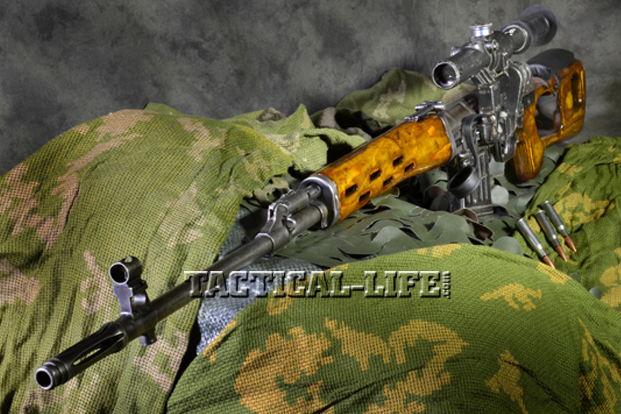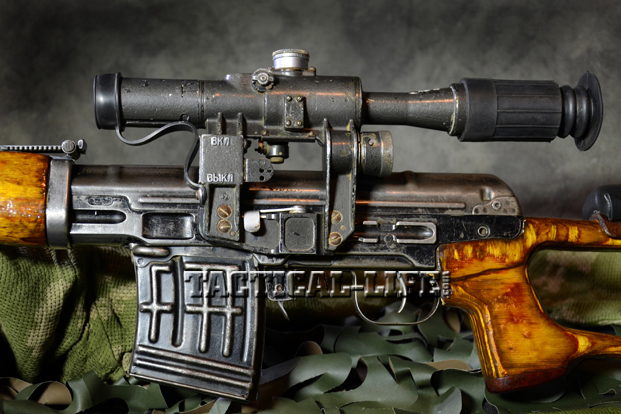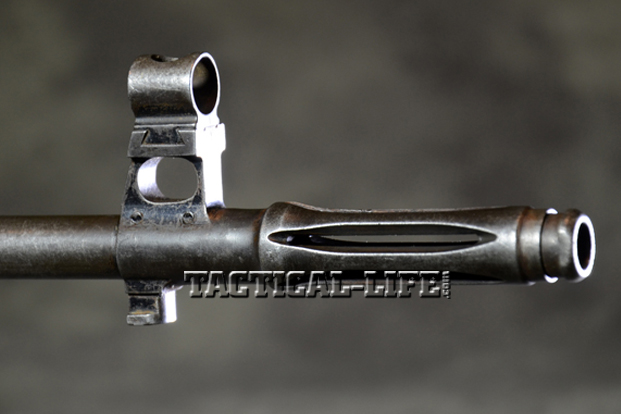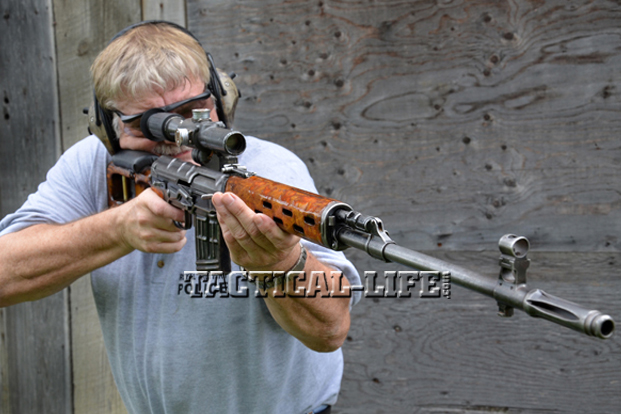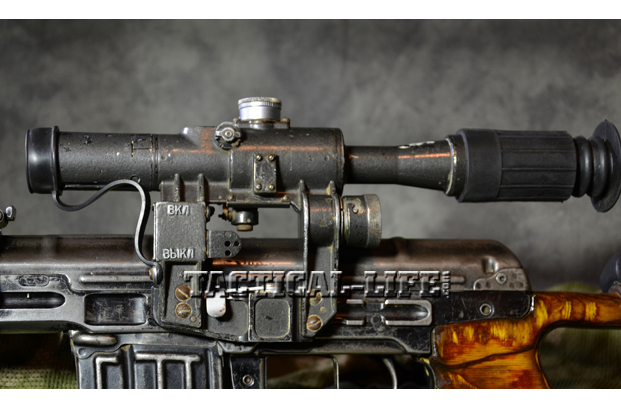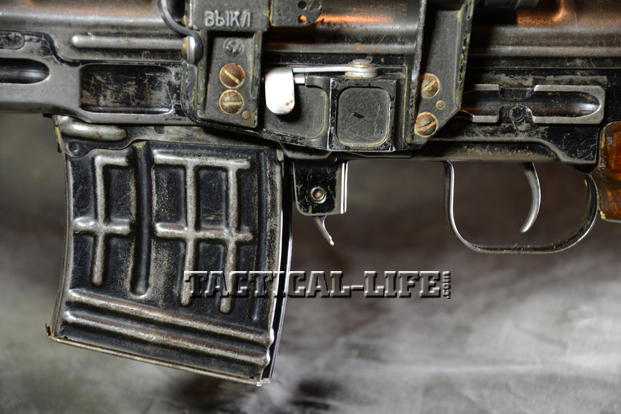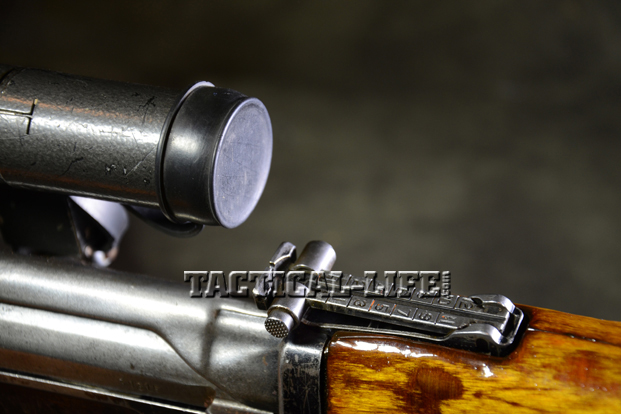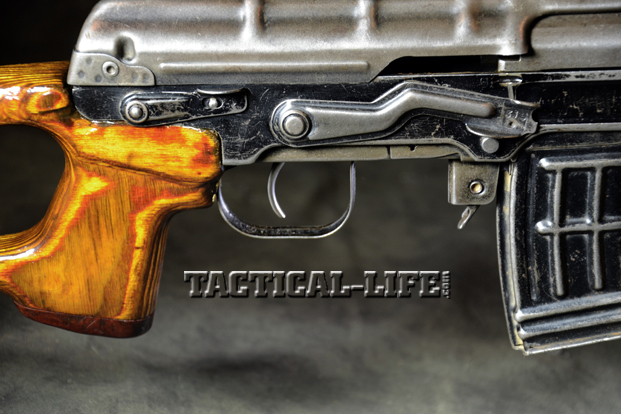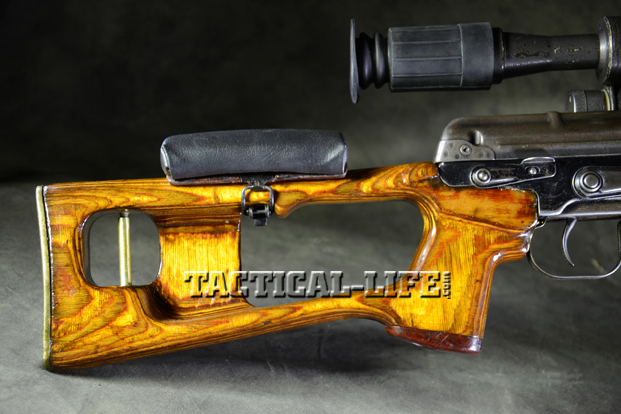If you had $25,000 in 1975, that would be worth $106,383 today. (A few of you who remember the war in Southeast Asia probably know where I’m going with this.) During and immediately after the Vietnam War, U.S. intelligence agencies were offering $25,000 for a Dragunov sniper rifle. Though it had been produced in the Soviet Union since 1963, it was virtually unknown in the West. At the time there were descriptions of it, but even photos were unavailable. There were some reports of Soviet snipers with North Vietnamese units using the Dragunov against U.S. troops. However, none of the snipers were captured, nor were their rifles.
Tracking It Down
Even today, the Dragunov—meaning a real Russian Dragunov sniper rifle—is rarely encountered in the U.S. A faux Dragunov, the Romanian PSL, is fairly common in the U.S. But where the Dragunov uses a gas-operated short-stroke piston system with a rotating bolt, the PSL uses a long-stroke system based on the AK-47. As I understand it, the Dragunov has a short-stroke system because it was believed that a long-stroke system would have a negative effect of battle rifles, Tigr rifles don’t look “right.” The Dragunov is also known as the SVD, or snayperskaya vintovka dragunova, which translates to “Dragunov sniper rifle.” Although it has functioned as a sniper rifle within the Russian armed forces for
almost 50 years, the SVD is really more akin to what the U.S. armed forces considers a designated marksman rifle. The SVD was intended to give a Russian squad a weapon with longer-range engagement capability than that of an AK-47 (or, more recently, an AK-74). One member of each Russian infantry squad was supposed to be armed with an SVD.
Gun Details
Since the Dragunov is a semi-automatic with a 10-round magazine, it is capable of fast follow-up shots when used in support of advancing infantry. It is also chambered for the same 7.62x54R round used by Russian snipers during World War II. That gives it more range than a 7.62x39mm AK-47 or a 5.45x39mm AK-74. Because the Dragunov fires the powerful 7.62x54R cartridge, the rotating bolt has three sturdy locking lugs. To enhance operation when dirty or in winter conditions, the SVD has a two-position gas regulator. The barrel is chrome-lined, as 7.62x54R ammo has been corrosive throughout much of the weapon’s service. There is a long flash suppressor at the end of the barrel, which also has a bayonet lug. An ex-Spetsnaz sniper I spoke with in Russia told me that many snipers felt their Dragunovs were more accurate with the bayonet mounted because it led to better barrel harmonics.
SVD stocks and handguards are distinctive. The skeleton stock is actually quite comfortable and lightens the rifle enough to make it relatively easy to fire off-hand, and the ventilated wooden handguards seem to help dissipate heat. A detachable cheekpiece is mounted on the stock for use with the scope. If the back-up iron sights are to be used, the cheekpiece is removed. Many sniping rifles do not have back-up iron sights, but they should—sniper rifles become useless if something happens to the scope. Because the Dragunov uses a side scope mount, the sights can be used when a scope is mounted.
Advertisement — Continue Reading Below
PSO-1 Scope
Speaking of the scope, the standard Dragunov scope is the PSO-1. When it was introduced in the 1960s, the PSO-1 was one of the most advanced military optics in the world, perhaps one of the reasons the Russians were so secretive about the SVD. The PSO-1’s magnification is 4x, and the reticle is illuminated by way of a battery. The reticle may be used for range-finding, holdover or lead. To allow for use in the harsh Russian winter, the PSO-1 incorporates a battery warmer. The scope has an elevation dial with a bullet-drop compensator and a metascope to identify an infrared source. A rubber eyepiece keeps peripheral light from distracting the shooter and also provides the correct 68mm eye relief for the scope. Even a half-century after it went into production, the PSO-1 remains quite usable, having acquired many targets around the world. The current generation is the PSO-1M2.
Sometimes Dragunovs designated “SVDN” are encountered. These guns will mount one of the Russian night-vision sights. The two passive night-vision scopes that I know have been used on the Dragunov are the 2.7x NSP-3 and the 3.4x PGN-1. (I believe the 1PN93-3 night sight used on the PKM machine gun has also been used on the Dragunov.) A Russian contact of mine who was in a Spetsnaz unit in Afghanistan had told me of using a Dragunov with night-vision optics. I believe it was a PGN-1, but our conversation had taken place 20 years ago, so I may have it wrong. My contact did say that they used the Dragunovs with night-vision optics out to 400 or 500 meters. (He also showed me the systema shoulder throw, while dropping to the knee, they used for throwing mujahideen off of cliffs in nighttime hand-to-hand combat!)
With standard 7.62x54R ammunition, the Dragunov was expected to shoot about 2 MOA; with the special 7N1 sniper rounds, slightly more than 1 MOA. However, that was theoretical: These groups were rarely achieved as I understand it. In 1999 the 7N1 was replaced by the 7N14 sniper round, which has an armor-piercing bullet. I have never fired the 7N14 round, but some years ago I got a chance to fire a couple of magazines of 7N1. The range did not have paper targets set up, so I fired at silhouettes from 200 yards and hit them every time. The PSO-1 on that rifle was zeroed at 200 yards. A batch of 7N1 rounds came into the U.S. a few years ago and got gobbled up quickly. I do occasionally see it for sale on GunBroker for about a dollar a round.
Other Incarnations
The Dragunov has been updated over its service life. The upgraded version often seen in use today has a synthetic skeleton stock and bipod and may mount a 3-9x42mm variable-power scope. There is also the SVDS, which was designed for use by airborne troops and incorporates a shorter barrel and folding buttstock. It is normally equipped with the PSO-1M2 scope, or with night-vision optics and designated the SVDSN. Although the Russians remained secretive about the Dragunov for some years, it was supplied to fellow Warsaw Pact armies or built on license. Eventually, other countries within the Soviet sphere received Dragunovs as well. U.S. shooters are probably most familiar with the Chinese Type 79, which was a licensed copy of the Russian SVD produced by Norinco. There were a few minor differences including, reportedly, a stock that was slightly shorter to allow for the smaller stature of Chinese soldiers. The first Dragunov I shot was a Type 79: Several years ago, some U.S. special ops units acquired Type 79s to use for Dragunov familiarization training, and I had a chance to shoot one. Some of the Type 79 Dragunovs were produced in 7.62x51mm NATO, and I am aware of one U.S. spec-ops unit that acquired those because of the readily available ammunition. There are some indications that the first Chinese Dragunovs were actually built in Russia and supplied to the Chinese. Today, the Norinco Dragunovs are quite sought after in the U.S., as not all that many were imported—around 2,000 by some estimates. In the last year I’ve seen 7.62x51mm NATO Type 79s go
for $5,000 and nice ones chambered for
7.62x54R go for $7,500. Note that sometimes Type 79s may be designated as Type
85s depending on which scope is used.
India also built Dragunovs under license, and Iran has produced a Dragunov-based weapon of its own, the Nakhjir Sniper Rifle. Finnish snipers use a well-made version of the Dragunov, the TKIV, produced by Sako. Many of those who have shot the TKIV consider it the most accurate Dragunov they’ve fired, though I have to admit a couple of Finns I know do not think very highly of it. On the other hand, Finns issued the 7.62mm TKIV tell me they prefer it, since it is much easier to carry than the heavier 8.6mm TKIV (Sako TRG-42) and its heavier ammo.
Virtually all of the other countries within the Soviet sphere of influence during the Cold War used the Dragunov. Some, like Ukraine, still do. Cuba had used the Dragunov, and I remember seeing one captured during the Grenada operation. Poland’s SWD-M was a modernized version of the SVD, with a heavier barrel, variable-power scope and detachable bipod. As with most Russian weapons, the Dragunov will continue to turn up in trouble spots for decades. In fact, Russian troops had faced Chechen snipers—often ex–Russian Army snipers—armed with Dragunovs during the war from 1999 to 2009. U.S. troops have faced Dragunovs in the hands of Chechen mercenary snipers in Iraq as well.
Advertisement — Continue Reading Below
Shooting Impressions
While preparing this article, I had a chance to shoot a Draugnov to re-acquaint myself with the rifle. Had I had some 7N1 sniper rounds available, I would have used those and then used boiling water to do a corrosive ammunition clean. However, I didn’t, so I took advantage of the fact that Century International Arms supplies Barnaul 7.62x54R, 185-grain, FMJ, non-corrosive ammunition and ordered 100 rounds. The Barnaul was actually heavier than the 152-grain 7N1 sniper load, but I was shooting to re-acquaint myself with the rifle, not to zero it for the standard sniper round. One of the first things I noticed was how light and handy the Dragunov feels compared to most sniping rifles. This rifle was meant to be carried by the long-range shooter in an infantry squad— emphasis on carried. Though squad marksmen normally used a sling with the Dragunov some of the time, the Dragunov I shot did not have a sling mounted. As usual, I find the AK-type safety relatively slow to operate: I have to remove the thumb from the pistol grip or use the trigger finger. This is actually less of a problem for a sniper rifle than for an AK that’s likely to be carried by a point man. I would probably carry the SVD with the safety off and an empty chamber and reach over with my support hand to rack the bolt. The scope gets in the way to some extent, but I have performed the action quite a few times and it works.
In the past I’ve studied translations of the SVD and PSO-1 manuals, to learn how to use the various features of the reticle including ranging. Here I figured it was unnecessary. Using the central chevron aiming point was sufficient and easy to use for precise aiming. For the most part, I used the chevron to shoot at plates from 100 and 200 yards. I did not adjust for elevation, just my aiming point. From a standing rest, I was hitting the plates virtually every time, and off-hand at 100 yards I was hitting consistently. The Dragunov’s trigger pull certainly isn’t what we’d expect for a true sniper rifle, but it is consistent and fairly crisp. I had done quite a bit of shooting with the .30-06 1903 Springfield recently and thought that would make a good basis of comparison with the 7.62x54R SVD. Subjectively, the SVD’s recoil seemed less noticeable, quite possibly because the semi-automatic operation of the bolt dampens felt recoil. I liked the Dragunov’s stock, though it felt just a tad short for me in terms of getting the best cheekweld and eye relief. The politically correct rifles that were imported with pistol-grip skeleton stocks offend me, but I like this Dragunov’s stock, probably because that’s the one with which it was issued. Other than wanting it an inch longer, I also find this stock very comfortable.
Final Thoughts
I have sniper rifles that I can consistently shoot half-MOA groups with. If on a very good day I shot a 2-MOA group with the Dragunov, I’d be thrilled. My other sniper rifles don’t feel as natural in the hands as the Dragunov does, nor do they lend themselves as well to a quick off-hand shot. There is something about the Dragunov. Maybe it has to do with the $25,000 award for capturing one, or that it’s likely to be seen in the hands of America’s enemies, from the Cold War to the War on Terror. But for me, honestly, much of the Dragunov’s appeal is aesthetic—stylish and deadly. ★
Advertisement — Continue Reading Below
